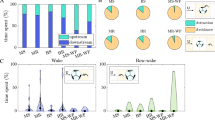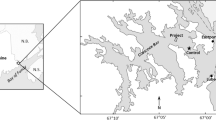Abstract
Energy from tidal streams is a reliable renewable energy source worth exploiting. With increasing concern over the potential effects of ocean energy utilization on marine environment and organisms, several previous experimental studies have been conducted focusing on fish behavior and their collision risk with hydrokinetic turbines for power generation. This study is aimed at exploring the behavior of marine animals around marine current turbines (MCTs) in the sea environment by conducting a laboratory experiment based on similarity laws for the turbine tip speed and maximum marine animal swimming speed. Three rotation frequencies (0, 5 and 20 rpm) with two releasing areas (upstream and downstream areas) were considered in our experiment. Results showed that fish survival rate was 100 % after 48 h, and only one fish came into contact with the turbine hub and was inactive in front of it when the MCT was in a stationary state during our preliminary test of swimming endurance. Although both the initial releasing area of fish and the rotation speed of MCT have significant effects on fish passage count rate (PCR) via a turbine, there is no interaction between these two factors. PCR was generally higher when fish were put into the tank in the downstream area, irrespective of the turbine rotation. And the returning behavior in the downstream area was more frequently found compared with that in the upstream area, which indicates that the location of MCTs should be considered at the downstream of a channel in practice to reduce the potential risk of fish injury. The ratio of fish passing from the outer side (±3) of the turbine was larger, and a clear U-shaped distribution could be observed. The entering behavior almost disappeared (less than 1.3 %) when MCT rotated with a frequency of 20 rpm. It indicates the design of the rotation frequency of MCT should be more than 20 rpm. However, higher tip speeds and darkness conditions are not considered in our experiment. Based on the laws of similarity proposed in this study, it becomes possible to compare the experimental results with real sea results, to allow explanation and discussion of fish behavior around MCTs, through the parameters of flow velocity, turbine tip speed, and maximum fish swimming speed.










Similar content being viewed by others
References
Mofor L, Goldsmith J, Jones F (2014) Ocean energy: technology readiness, patents, deployment status and outlook. International Renewable Energy Agency (IRENA), Abu Dhabi
Tethys (2009) http://mhk.pnl.gov/. Accessed 15 Jan 2015
The Scottish Government Marine & Fisheries (2011) http://www.scotland.gov.uk/Topics/marine. Accessed 15 Jan 2015
Polagye B, Cleve BV, Copping A, Kirkendall K (2011) Environmental effects of tidal energy development: proceedings of a scientific workshop 22–25 March 2010, US National Oceanographic and Atmospheric Administration
Smallwood KS, Thelander CG (2004) Developing methods to reduce bird mortality in the Altamont Pass Wind Resource Area. California Energy Commission
Amaral S, Perkins N, Giza D, McMahon B (2011a) Evaluation of fish injury and mortality associated with hydrokinetic turbines. Electric Power Res Inst Rep 1024569:1–108
Amaral S, Hecker G, Pioppi N (2011b) Fish passage through turbines: application of conventional hydropower data to hydrokinetic technologies. Electric Power Res Inst Rep 1024638:1–56
Castro-Santos T, Haro A (2015) Survival and behavioral effects of exposure to a hydrokinetic turbine on juvenile Atlantic Salmon and adult American Shad. Estuaries Coasts 38(1):203–214
Viehman HA, Zydlewski GB (2014) Fish interactions with a commercial-scale tidal energy device in the natural environment. Estuaries Coasts 38(1):241–252
Li Y, Çalişal SM (2010) Numerical analysis of the characteristics of vertical axis tidal current turbines. Renew Energy 35(2):435–442
Von Raben K (1957) Regarding the problem of mutilations of fishes by hydraulic turbines. Die Wasserwirtschaft 4:97–100
Deng Z, Carlson TJ, Ploskey GR, Richmond MC, Dauble DD (2007) Evaluation of blade-strike models for estimating the biological performance of Kaplan turbines. Ecol Model 208(2):165–176
Triantafyllou GS, Triantafyllou MS, Grosenbaugh MA (1993) Optimal thrust development in oscillating foils with application to fish propulsion. J Fluids Struct 7(2):205–224
Taylor GK, Nudds RL, Thomas AL (2003) Flying and swimming animals cruise at a Strouhal number tuned for high power efficiency. Nature 425(6959):707–711
Nudds RL, Taylor GK, Thomas AL (2004) Tuning of Strouhal number for high propulsive efficiency accurately predicts how wingbeat frequency and stroke amplitude relate and scale with size and flight speed in birds. Proc Royal Soc Lond B Biol Sci 271(1552):2071–2076
Nudds RL, John EL, Keen AN, Shiels HA (2014) Rainbow trout provide the first experimental evidence for adherence to a distinct Strouhal number during animal oscillatory propulsion. J Exp Biol 217(13):2244–2249
Videler JJ, Wardle CS (1991) Fish swimming stride by stride: speed limits and endurance. Rev Fish Biol Fisheries 1(1):23–40
Claireaux G, Couturier C, Groison AL (2006) Effect of temperature on maximum swimming speed and cost of transport in juvenile European sea bass (Dicentrarchus labrax). J Exp Biol 209(17):3420–3428
Tanaka I, Nagai M (1996) The fluid dynamics of the drag and propulsive force: learning from the high swimming capacity of aquatic animals. Japan Ocean Foundation, pp 219
Bainbridge R (1958) The speed of swimming of fish as related to size and to the frequency and amplitude of the tail beat. J Exp Biol 35(1):109–133
Triantafyllou MS, Triantafyllou GS, Gopalkrishnan R (1991) Wake mechanics for thrust generation in oscillating foils. Phys Fluids A Fluid Dyn 3(12):2835–2837
Rohr JJ, Fish FE (2004) Strouhal numbers and optimization of swimming by odontocete cetaceans. J Exp Biol 207(10):1633–1642
Rohr JJ, Hendricks EW, Quigley L, Fish FE, Gilpatrick JW, Scardina-Ludwig J (1998) Observations of dolphin swimming speed and Strouhal number. Space Nav Warfare Syst Ctr Tech Rep San Diego
Tytell ED (2004) The hydrodynamics of eel swimming II: effect of swimming speed. J Exp Biol 207(19):3265–3279
Teyke T (1985) Collision with and avoidance of obstacles by blind cave fish Anoptichthys jordani (Characidae). J Comp Physiol A 157(6):837–843
Cuthill I, Guilford T (1990) Perceived risk and obstacle avoidance in flying birds. Anim Behav 40(1):188–190
Coutant CC, Whitney RR (2000) Fish behavior in relation to passage through hydropower turbines: a review. Trans Am Fish Soc 129(2):351–380
Turnpenny AWH, Davis MH, Fleming JM, Davies JK (1992) Experimental studies relating to the passage of fish and shrimps through tidal power turbines. Marine and Freshwater Biology Unit (National Power, Fawley, Southampton, England)
Jones FH (1963) The reaction of fish to moving backgrounds. J Exp Biol 40(3):437–446
Liao JC, Beal DN, Lauder GV, Triantafyllou MS (2003) Fish exploiting vortices decrease muscle activity. Science 302(5650):1566–1569
Blaxter JHS, Batty RS (1985) Herring behaviour in the dark: responses to stationary and continuously vibrating obstacles. J Mar Biol Assoc the UK 65(04):1031–1049
Popper AN, Higgs DM (2009) Fish: Hearing, lateral lines (mechanisms, role in behavior, adaptations to life underwater). In: Encyclopedia of ocean sciences. Academic, Oxford, pp 476–482
Eriksson S, Bernhoff H, Leijon M (2008) Evaluation of different turbine concepts for wind power. Renew Sustain Energy Rev 12(5):1419–1434
Batten WMJ, Bahaj AS, Molland AF, Chaplin JR (2006) Hydrodynamics of marine current turbines. Renew Energy 31(2):249–256
Wang D, Atlar M, Sampson R (2007) An experimental investigation on cavitation, noise, and slipstream characteristics of ocean stream turbines. Proc Inst Mech Eng Part A J Power Energy 221(2):219–231
Wardle CS (1975) Limits of fish swimming speed. Nature 255:725–727
Wardle CS (1986) Fish behaviour and fishing gear. The behaviour of teleost fishes. Springer, US, pp 463–495
Rakowitz G, Tušer M, Říha M, Jůza T, Balk H, Kubečka J (2012) Use of high-frequency imaging sonar (DIDSON) to observe fish behavior towards a surface trawl. Fish Res 123–124:37–48
Acknowledgments
This study was partially supported by the New Energy Common Infrastructure Promotion Program sponsored by the Ministry of Economy, Trade, and Industry and the Agency for Natural Resources and Energy.
Author information
Authors and Affiliations
Corresponding author
About this article
Cite this article
Zhang, J., Kitazawa, D., Taya, S. et al. Impact assessment of marine current turbines on fish behavior using an experimental approach based on the similarity law. J Mar Sci Technol 22, 219–230 (2017). https://doi.org/10.1007/s00773-016-0405-y
Received:
Accepted:
Published:
Issue Date:
DOI: https://doi.org/10.1007/s00773-016-0405-y




